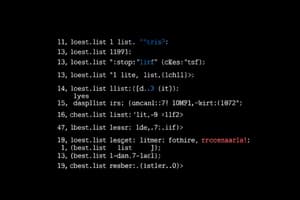Podcast
Questions and Answers
Which definition is utilized when executing the expression (dots compose abs)(-3)?
Which definition is utilized when executing the expression (dots compose abs)(-3)?
- The first definition of `abs`.
- The second definition of `abs1`.
- A composition of `abs` and `dots`. (correct)
- None of the above.
What will be the output of shorten("Functional Programming", 20)?
What will be the output of shorten("Functional Programming", 20)?
- Functional Programmin...
- Functional Programming
- Functional Progra... (correct)
- Functional Programming...
What does the abs1 function return when called with the argument -3?
What does the abs1 function return when called with the argument -3?
- 0
- Undefined
- 3 (correct)
- -3
Which of the following expressions will produce the same result as a.to(b)?
Which of the following expressions will produce the same result as a.to(b)?
What result does (abs andThen dots)(-3) produce?
What result does (abs andThen dots)(-3) produce?
What type of data structure is created when Edge(a, b) is called?
What type of data structure is created when Edge(a, b) is called?
What will be the output of the function call formatMessage("hello", "Joe")?
What will be the output of the function call formatMessage("hello", "Joe")?
What is the return value of the expression average(1.0, 2.3, 4.5)?
What is the return value of the expression average(1.0, 2.3, 4.5)?
Which form of calling the average function utilizes variable-length argument lists?
Which form of calling the average function utilizes variable-length argument lists?
What is the type of the parameter for the first function?
What is the type of the parameter for the first function?
What will the result of first((1, 2)) - 10 be?
What will the result of first((1, 2)) - 10 be?
Flashcards are hidden until you start studying
Study Notes
Functional Programming Concepts
- Absolute Value Function: Defined using an if-else expression to return the positive version of an integer. Example:
def abs(x: Int): Int = if x > 0 then x else -x. - String Repetition: The function
dots(length: Int)generates a string consisting of dots based on the specified length, achieved through string multiplication:"." * length.
Functional Composition
- Function Composition: Utilizes
(dots compose abs)(-3)to applyabsfirst and thendotson the result. - Function Chaining:
(abs andThen dots)(-3)appliesabsand then passes the output todots, demonstrating another method of combining functions.
Graph Structure
- Graph Class Definitions:
class Edge(from: Node, to: Node)defines a connection between nodes.class Nodefeatures methods for creating edges:infix def to(that: Node): Edgeallows an infix style for establishing edges.def --> (that: Node): Edgeenables a more natural syntax for connecting nodes.
Node Interactions
- Examples of creating nodes (
val a = Node(); val b = Node()) and connecting them using both defined methods:a.to(b)anda --> bdemonstrate multiple ways to establish relationships between nodes.
String Manipulation
- String Shortening Function:
def shorten(str: String, maxLen: Int): Stringtruncates a string if its length exceedsmaxLen, appending "..." to indicate truncation. - Extension Methods: An extension method to simplify the shortening process can be added, allowing strings to call the
shortfunction directly, e.g.,"Functional Programming".short(20).
Alternatives for Absolute Value
- Enhanced Absolute Value Implementation:
abs1uses a localmaxfunction to calculate the maximum value between the input and its negation:def abs1(x: Int): Int = def max(a: Int, b: Int) = if a > b then a else b.abs2uses a more closure-like approach by definingmaxX, which compares the input value against its negation:def abs2(x: Int): Int = def maxX(a: Int) = if a > x then a else x.
Each method showcases different programming paradigms within functional programming, such as higher-order functions, method overloading, and the usage of extensions for adding functionality to existing types.
String Formatting Function
formatMessagefunction creates a formatted message string with optional user prefix and newline.- Takes three parameters:
msg(String),user(String, default "") andwithNewline(Boolean, default true). - Utilizes
StringBuilderfor string construction for efficiency. - If
useris provided and non-empty, it appendsuser:to the message. - Appends
msgto the constructed string. - Depending on
withNewline, a newline character can be added after the message.
Usage Examples
formatMessage("hello")returns "hello\n".formatMessage("hello", "Joe")returns "Joe:hello\n".formatMessage("hello", "Joe", false)returns "Joe:hello" (no newline).- Using named parameters for clarity, e.g.,
formatMessage("hello", "Joe", withNewline = false).
Average Calculation Function
averagefunction computes the mean of given numbers.- Takes
first(Double) and a variable number of additionalothers(Double*). - Calculates the average as the sum of
firstandothersdivided by their total count (1 + length of others).
Usage Examples
average(1.0, 2.3, 4.5)returns 2.3 as the average.average(1.0, 2.3)returns 1.65, averaging the two numbers.average(10.0)returns 10.0, the average of a single number.- Can pass a list of numbers using the splat operator, e.g.,
val nums = List(2.3, 4.5); average(1.0, nums*).
Tuple Handling Functions
first_badretrieves the first element of a tuple but is typed toAny, noting potential unsafe type handling.first_better[A]is a type-safe version retrieving the first element of a tuple of the same type.first[A, B]generically retrieves the first element from a tuple with two different types.
Example Usage of Tuple Functions
first((1, 2))results in1.first(("chicken", "egg")).toUpperCasereturns "CHICKEN".first(("chicken", 2)).toUpperCasecalls an unsafe operation due to mismatched types.
Higher-Order Functions
- Functions like
f[B, A]andg[T, U]demonstrate how to define higher-order functions that generically handle tuples while retrieving elements. - Notably,
f((1, "X"))infers the types correctly asAandB. - Type parameters can be explicitly specified, e.g.,
f[String, Int]((1, "X")).
Studying That Suits You
Use AI to generate personalized quizzes and flashcards to suit your learning preferences.





